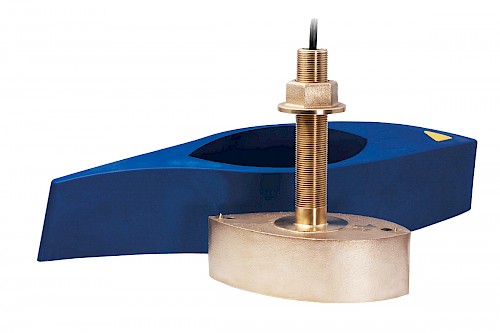
CHIRP-ing the Deep
Since the 1950's, the military and oceanographers have been using CHIRP (Compressed High Intensity Radar Pulse) sounding technology. In late 2009, major marine manufacturers started offering CHIRP, FM and Spread-Spectrum fishfinders and broadband transducers for the recreational market. Let’s take a look at why this technology is so great for boaters
How does it work? Sounders work by bouncing a pulse of sound off objects. Traditional fish finders, or echo sounders, transmit at a single fixed frequency, typically either 50 kHz or 200 kHz, and generally for a very short time period. There is a trade-off between target resolution and target depth. A shorter pulse provides clearer images, but will only show shallow details. A longer pulse will emit more energy, which is necessary to show results from deeper depths, but will result in a loss of detail. If the pulse is longer, the echoes from two objects can merge into one long echo.
With CHIRP this trade-off is no longer an issue. Instead of pinging a single frequency, CHIRP fish finders transmit a range of frequencies, for example 28 to 60kHz or 130 to 210kHz and the pulses are ten times as long in duration. Referred to as pulse compression, this advanced signal processing allows for unprecedented resolution and target definition. It is like switching from analog to HD. The picture on the screen looks like an ultrasound image and reveals life-like views of vegetation, rocks, sand, fish, and even outcroppings that do not appear on traditional charts. In the past, the actual black box was commonly installed separately from the multi-function display, now many units come with the sounder processor built-in, taking up less space, less wiring and less setup.
The three types of CHIRP. There are three basic CHIRP frequencies, depending on how you use your boat. High CHIRP (150 - 240kHz, 455/800kHz) is best for inland or freshwater fishing and depths less than 600 feet. Medium CHIRP (80 - 160kHz) scans larger areas faster but provides less detail than high CHIRP and is also best for depths less than 600 feet. Low CHIRP (below 80kHz) is recommended for depths over 600 feet and can, in best conditions, detect depths up to 10,000 feet with a very strong transducer (e.g. 1000 watts). In reality those max numbers are rarely achieved, so when choosing a saltwater transducer for Pacific Northwest waters, choose a low CHIRP transducer that is 300 to 600 watts in power. Newer fish finders allow you to operate two independent transducers or one transducer covering two CHIRP frequency ranges at the same time.
The transducer. To take full advantage of your CHIRP fish finder you will need a CHIRP transducer. Companies, like Airmar, offer transducers designed with ceramics to operate over a broad range of frequencies along with the ability to not only look down but to the side or all around. They have also created a wide beam sonar which increased the chirp beam from 10 degrees to 25 degrees.
There are a number of different ways to install these transducers such as a thru-hull, tilted element, transom mount, or in-hull. Transducers can even be clamped to the outside of a trolling motor. Location is critical, and different for sailboats and powerboats. The goal of selecting a transducer location is to minimize nearby obstructions and thru-hulls that will create turbulence and bubbles, and to ensure the transducer will always be in the water even while underway at speed or heel. For example, one typical location on sailboats is in front of the keel, while for powerboats you want it two-thirds aft and centre, so it stays in the water when you’re planing. A poor location will result in very poor performance, so do some research and make sure it’s right for your boat.
If you are thinking of adding CHIRP to your boat, there are a number of different options from every major manufacturer. Garmin refers to it as ClearVü, SideVü or DownVü whereas Lowrance calls is SideScan or DownScan. Products like the Lowrance Elite and HDS Gen3 Touch models and Gen2 with SonarHub do not require a separate transducer as the technology is built in to the Lowrance skimmer transducer. Lowrance Hook combos pair their 455/800kHz scanning sonar with Low, Med, High CHIRP, centered on 50/83/200kHz frequencies. Raymarine’s Dragonfly GPS/Chartplotters combine a conical 170-230kHz CHIRP sonar with a wide-beam 320-380kHz CHIRP scanning sonar element. And one of the most economical options is the Garmin Striker™ series which includes a dual beam 77/200kHz transducer with prices starting at $150.
CHIRP sonar systems get the best quality images and detail that just aren't possible with conventional sonar systems. Serious anglers can see individual fish and features near the bottom and throughout the water column, as well as underwater bottom contours and features. Experienced anglers can determine the different species and sizes of fish that are picked up best at specific frequencies. This is great for boaters because you no longer have to choose between depth or detail.
About the author: Jeff Cote is the owner of Pacific Yacht Systems, a full service shop delivering marine electrical and navigation solutions for recreational boats. Visit their website and blog for info and articles on marine electrical systems, projects and more: www.pysystems.ca.
Related Content






 $391.99
$391.99 $276.58
$276.58



















